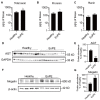Megalin, Proton Pump Inhibitors and the Renin-Angiotensin System in Healthy and Pre-Eclamptic Placentas
- PMID: 34299027
- PMCID: PMC8306182
- DOI: 10.3390/ijms22147407
Megalin, Proton Pump Inhibitors and the Renin-Angiotensin System in Healthy and Pre-Eclamptic Placentas
Abstract
Soluble Fms-like tyrosine kinase-1 (sFlt-1) is increased in pre-eclampsia. The proton pump inhibitor (PPI) lowers sFlt-1, while angiotensin increases it. To investigate whether PPIs lower sFlt-1 by suppressing placental renin-angiotensin system (RAS) activity, we studied gene expression and protein abundance of RAS components, including megalin, a novel endocytic receptor for prorenin and renin, in placental tissue obtained from healthy pregnant women and women with early-onset pre-eclampsia. Renin, ACE, ACE2, and the angiotensin receptors were expressed at identical levels in healthy and pre-eclamptic placentas, while both the (pro)renin receptor and megalin were increased in the latter. Placental prorenin levels were upregulated in pre-eclamptic pregnancies. Angiotensinogen protein, but not mRNA, was detectable in placental tissue, implying that it originates from maternal blood. Ex vivo placental perfusion revealed a complete washout of angiotensinogen, while prorenin release remained constant. The PPI esomeprazole dose-dependently reduced megalin/(pro)renin receptor-mediated renin uptake in Brown Norway yolk sac epithelial cells and decreased sFlt-1 secretion from placental villous explants. Megalin inhibition blocked angiotensinogen uptake in epithelial cells. In conclusion, our data suggest that placental RAS activity depends on angiotensinogen taken up from the maternal systemic circulation. PPIs might interfere with placental (pro)renin-AGT uptake/transport, thereby reducing angiotensin formation as well as angiotensin-induced sFlt-1 synthesis.
Keywords: megalin; pre-eclampsia; proton pump inhibitors; renin–angiotensin system.
Conflict of interest statement
The authors declare no conflict of interest.
Figures






 , inhibition; PPI, proton pump inhibitor; (P)RR, (pro)renin receptor; Ang I, angiotensin I; ACE, angiotensin-converting enzyme; Ang II, angiotensin II; AT1R, angiotensin II type 1 receptor; PE, pre-eclampsia; sFlt-1, soluble Fms-like tyrosine kinase-1; +, normal sensitivity to Ang II; +++, increased sensitivity to Ang II.
, inhibition; PPI, proton pump inhibitor; (P)RR, (pro)renin receptor; Ang I, angiotensin I; ACE, angiotensin-converting enzyme; Ang II, angiotensin II; AT1R, angiotensin II type 1 receptor; PE, pre-eclampsia; sFlt-1, soluble Fms-like tyrosine kinase-1; +, normal sensitivity to Ang II; +++, increased sensitivity to Ang II.References
-
- Rana S., Powe C.E., Salahuddin S., Verlohren S., Perschel F.H., Levine R.J., Lim K.H., Wenger J.B., Thadhani R., Karumanchi S.A. Angiogenic factors and the risk of adverse outcomes in women with suspected preeclampsia. Circulation. 2012;125:911–919. doi: 10.1161/CIRCULATIONAHA.111.054361. - DOI - PMC - PubMed
MeSH terms
Substances
Grants and funding
- 81800383/National Natural Science Foundation of China
- 81870605/National Natural Science Foundation of China
- ZDSYS20190902092903237/Shenzhen Key Laboratory of Metabolism and Cardiovascular Homeostasis
- JCYJ20170817093928508/Shenzhen Municipal Science and Technology Innovation Council
- JCYJ20190808170401660/Shenzhen Municipal Science and Technology Innovation Council
LinkOut - more resources
Full Text Sources
Miscellaneous

